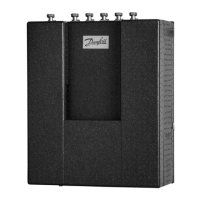
Do you have a question about the Danfoss Termix VVX-I-R FI - 7 Series and is the answer not in the manual?
| Brand | Danfoss |
|---|---|
| Model | Termix VVX-I-R FI - 7 Series |
| Category | Control Systems |
| Language | English |
Danfoss A/S' area of responsibility does not include balancing, scope of works or mounting and correct connection of the unit.
It is recommended that suitable work gloves are used in connection with handling and lifting of the heat interface unit.
The risk of personal injury or product damage increases considerably if the recommended operational parameters are exceeded.
Guidance on authorised personnel, electrical safety, and water ingress protection for components.
Covers installation requirements, hanging, handling, lifting, and re-tightening procedures.
Warnings regarding high pressure, temperatures, hot surfaces, sharp edges, and connection safety.
Requirements for safety valves and considerations for heat source connections.
Procedures for removing packaging and its disposal according to local legislation.
Installation and commissioning must be performed by an authorised HVAC technician.
Instructions on lifting the unit by its pipes or back plate.
Checking for transit damage before installation.
Ensuring adequate space, correct orientation, and tightening connections before installation.
Fitting the strainer according to the schematic diagram.
Steps for checking connections, filling with water, venting, and monitoring operation.
Re-tightening union fittings after filling and system operation.
Details on 230V connection, potential bonding, disconnection, and authorised electrician requirements.
Includes safety notes, preventing contact with hot pipes, and avoiding sharp edges.
Diagram illustrating wiring for radiator heating systems.
Diagram illustrating wiring for underfloor heating systems.
Instructions for mounting energy meters using the fitting piece and sensor pocket.
Setting pump speed, starting the pump, opening valves, and checking strainers.
Managing pump stop for UFH and warranty implications of continuous flow.
Details on thermoactuators, RAVK controllers, and sensor removal.
Adjusting the AVPL for stable system pressure regulation.
Understanding and selecting control modes for the UPM3 circulator pump.
Guide to UPM3 pump operation, settings, and alarm status interpretation.
Suggested pump settings for different heating system configurations.
Purpose of the safety valve and access procedures for maintenance.
Details on the IHPT 180 controller for domestic hot water temperature adjustment.
How the pressure absorber reduces system pressure and noise.
Information on circulation pipes and pumps for domestic hot water re-circulation.
Checks for strainers, meters, temperatures, connections, safety valves, and venting.
Guidance on who performs maintenance and ordering spare parts.
Verifying power supply, strainer cleanliness, flow temperature, and differential pressure.
Measures to take after troubleshooting, including tightening, cleaning, and balancing.
Solutions for incorrect DHW temperature, low flow, and space heating temperature issues.
Addressing high primary return temperature, noise, and pump performance problems.
Ensuring isolation valves are closed, power is off, and the unit has cooled.
Information on disposing of the product according to local legislation.
Verifying connections, flushing, strainers, pressure, and venting for handover.
Confirming controller settings, pump configuration, and insulation remounting.